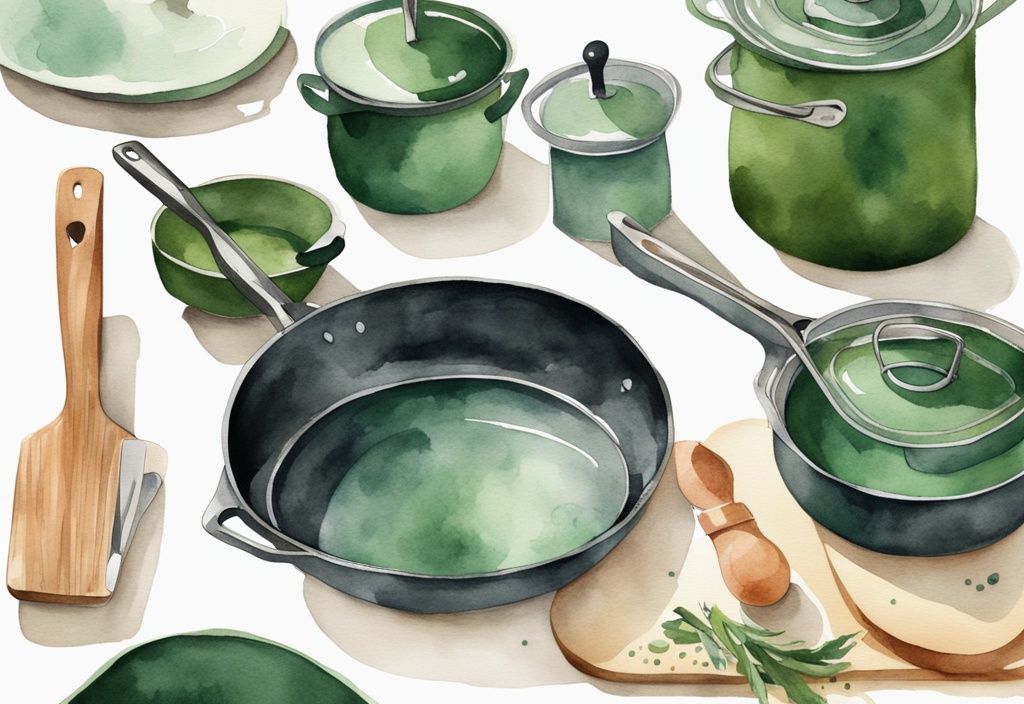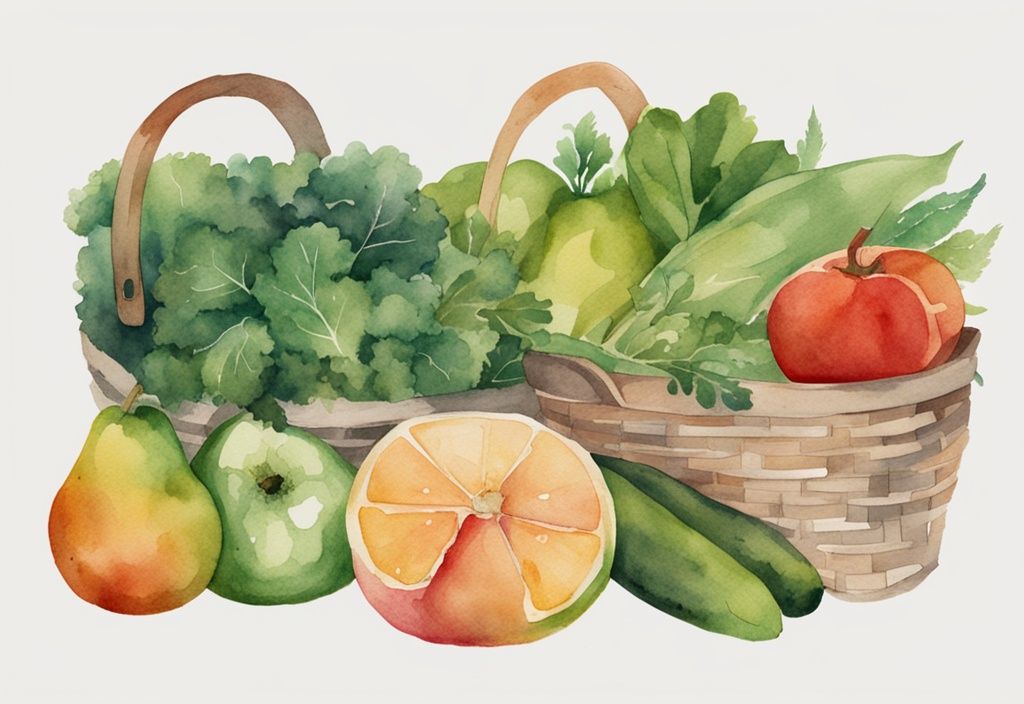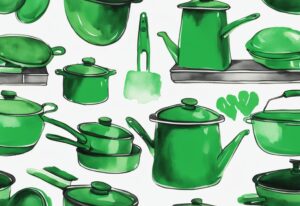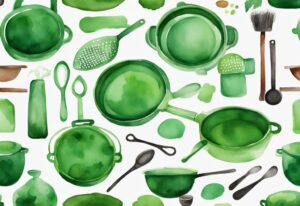Is Carbon Steel Safe for Cooking? Unveil Truth
Have you ever wondered, “Is carbon steel safe for cooking?” As an advocate for non-toxic living, I’ve been exploring this question myself. Carbon steel cookware, with its eco-friendly allure and non-toxic composition, is making waves in kitchens worldwide. But, are there any hidden concerns we should be aware of?
In this article, we’ll delve into the ins and outs of carbon steel. We’ll explore its durability, how it handles heat, and how to maintain it. We’ll also address those nagging worries about iron leaching and reactivity with acidic foods.
Whether you’re an eco-conscious cook or simply seeking durable cookware, understanding carbon steel’s pros and cons is crucial. So, let’s embark on this journey together and discover if carbon steel is the right choice for your kitchen.
Safety Aspects of Carbon Steel
Exploring the safety of carbon steel for cooking opens up a world of reassurance and practicality. This section delves into its non-toxic nature, addresses concerns about iron leaching, and highlights its capability to handle high temperatures, ensuring a safe and enjoyable cooking experience.
Non-Toxic Nature of Carbon Steel
When I first started my journey towards non-toxic living, the question is carbon steel safe for cooking? was at the forefront of my mind. The answer, thankfully, is a comforting yes. Carbon steel, made up of 99% iron and 1% carbon, is a non-toxic material that doesn’t introduce harmful chemicals into your meals. Unlike some non-stick pans that might contain PFOA or PFAS, carbon steel is free from these substances, ensuring a safe cooking experience. However, it’s important to be aware that not all cookware labeled as non-toxic is truly free from harmful chemicals. For more insights, check out this article on [non-toxic cookware claims](https://www.consumerreports.org/toxic-chemicals-substances/you-cant-always-trust-claims-on-non-toxic-cookware-a4849321487/). Its simple and natural composition also makes it an eco-friendly choice, appealing to those of us who are environmentally conscious and prioritize sustainability in our kitchenware.
Potential Concerns About Iron Leaching
Another question that often arises is whether carbon steel is safe for cooking due to iron leaching. While it’s true that iron can leach into food during cooking, this is generally not harmful. In fact, for those of us with iron deficiencies, this can be a hidden benefit. The amount of iron leached is typically minimal and doesn’t pose a risk to most people. Thus, carbon steel remains a safe and practical choice for everyday cooking, providing an additional source of dietary iron without compromising safety.
Handling High Temperatures with Carbon Steel
One of the standout features of carbon steel is its ability to withstand high temperatures, which often leads to the question, is carbon steel safe for cooking at high heat? Carbon steel can be heated up to 1200°F without damaging its surface, making it ideal for grilling, oven roasting, and other high-temperature cooking methods. However, it’s important to note that the handles on carbon steel pans can become very hot. To ensure safety while cooking, using a silicone sleeve or oven mitts is recommended. This combination of heat resilience and safety precautions makes carbon steel a versatile and reliable choice in the kitchen.
Understanding Carbon Steel Cookware
Carbon steel cookware is a popular choice among those seeking safe and sustainable cooking solutions. Its composition and durability make it a standout option for anyone looking to invest in long-lasting kitchenware. Let’s explore why carbon steel is both a safe and eco-friendly choice for your culinary adventures.

Composition and Eco-Friendliness of Carbon Steel
When I first discovered carbon steel cookware, I was drawn to its simplicity. Composed of 99% iron and 1% carbon, it felt like a breath of fresh air compared to the complex, synthetic-coated options out there. This straightforward composition means that carbon steel is free from harmful chemicals, making it a safe choice for cooking.
What I love most is its eco-friendly nature. Choosing carbon steel aligns perfectly with my values of reducing my ecological footprint. It’s a sustainable option that not only benefits personal health but also supports the environment. The absence of synthetic additives makes it an appealing choice for anyone who cares about both their well-being and the planet.
Durability and Longevity of Carbon Steel Cookware
One of the things I appreciate most about carbon steel cookware is its durability. It’s like having a trusty friend in the kitchen that stands the test of time. I’ve found that with proper care, these pans can last for generations. Their robust nature allows them to withstand daily use without showing signs of wear and tear.
Seasoning the cookware is a crucial step in maintaining its non-stick properties and preventing rust. It’s a small effort that pays off in the long run, ensuring the cookware remains a safe and effective tool in my kitchen. This resilience makes carbon steel a preferred choice for those seeking long-lasting, non-toxic cookware solutions.
For anyone looking to make a wise investment in their kitchen, carbon steel offers both reliability and peace of mind.
Cooking Considerations with Carbon Steel
Cooking with carbon steel can be a rewarding experience, offering a blend of durability and performance. However, understanding its unique properties is essential to ensure both safety and longevity in your kitchen adventures.
Reactivity of Carbon Steel with Acidic Foods
Cooking with carbon steel has been a delightful journey for me, yet I often ponder, is carbon steel safe for cooking, especially with acidic foods? Carbon steel is indeed reactive with ingredients like tomatoes, wine, and citrus. This reactivity can strip away the pan’s precious seasoning layer if acidic foods linger too long. If you’re curious about whether other products, like Burt’s Bees, contain SPF, you might want to explore this article on does Burt’s Bees have SPF. The seasoning is vital—it creates a natural non-stick surface and shields the pan from rust. I’ve learned to keep the cooking time short when using acidic ingredients, preserving the seasoning and ensuring my cookware remains in top-notch condition. This approach not only maintains the pan’s integrity but also guarantees a safe cooking experience.
Heat Distribution and Cooking Techniques for Carbon Steel
Another aspect to consider when questioning if carbon steel is safe for cooking is its heat distribution. Carbon steel heats up rapidly, making it a favorite for searing and browning. However, its thinness can lead to uneven heat distribution. This means I need to be vigilant, avoiding hot spots to achieve consistent results. Despite this, I love how lightweight carbon steel is compared to cast iron, making it easy to handle. Investing in quality pans is crucial; cheaper ones might be too thin, compromising heat distribution. By choosing the right cookware and honing my cooking techniques, I’ve found that carbon steel offers a safe and enjoyable cooking experience.

Proper Maintenance and Seasoning of Carbon Steel
Exploring the world of carbon steel cookware opens up a realm of culinary possibilities, but it also raises an important question: is carbon steel safe for cooking? Let’s delve into the art of seasoning and the essential maintenance practices that ensure your cookware remains a safe and reliable kitchen partner.
The Importance of Seasoning Carbon Steel
Seasoning carbon steel is like nurturing a friendship that grows stronger over time. When I first started using carbon steel pans, I quickly learned that seasoning was the secret to unlocking their full potential. This process creates a non-stick surface, transforming the pan into a versatile tool for cooking everything from delicate omelets to hearty steaks. But it’s not just about convenience; seasoning acts as a shield, protecting the pan from rust and wear. This protective layer is the key to longevity, ensuring your investment pays off for years to come.
Regular seasoning is more than just a routine; it’s a commitment to maintaining the pan’s quality and functionality. As you continue to season your pan, you’ll find yourself answering the question, is carbon steel safe for cooking, with confidence. A well-seasoned pan is a testament to the safety and non-toxic nature of carbon steel, allowing you to savor each meal without worry.
Preventing Rust on Carbon Steel Cookware
Rust prevention is a crucial aspect of keeping your carbon steel cookware safe and effective. I remember the first time I noticed a hint of rust on my pan; it was a wake-up call to the importance of proper care. Rust can compromise both safety and performance, but with a few simple steps, you can keep your cookware in pristine condition.
Hand washing your pan and drying it thoroughly after each use is essential. Moisture is rust’s best friend, so storing your pan in a dry place is a must. I also recommend applying a light coat of oil after cleaning. This not only preserves the seasoning but also adds an extra layer of protection. By following these maintenance tips, you’ll find yourself confidently answering the question, is carbon steel safe for cooking, with a resounding yes. Your cookware will remain a steadfast companion in your journey towards healthier, non-toxic living.
FAQ
Is it safe to cook acidic foods in carbon steel pans?
From my own kitchen adventures, I can assure you that cooking acidic foods in carbon steel pans is generally safe. However, I’ve learned that if you cook these foods for too long, the seasoning layer might start to wear off. So, when I’m making a tomato-based sauce or using citrus, I try to keep the cooking time short. This way, I preserve the pan’s quality and enjoy my meals without worry.

Can carbon steel cookware be used on induction cooktops?
Oh, the versatility of carbon steel cookware never ceases to amaze me! Yes, you can absolutely use it on induction cooktops. I’ve tried it on various cooking surfaces, from stovetops to grills, and even in the oven. It’s like having a reliable friend in the kitchen that adapts to all my cooking whims.
How often should I season my carbon steel pan?
In my experience, regular seasoning is key to keeping your carbon steel pan in top shape. After a busy cooking session, I make it a habit to re-season. This simple act ensures that the pan maintains its non-stick charm and continues to perform beautifully. It’s a small effort that pays off in the long run.
What should I do if my carbon steel pan starts to rust?
Don’t worry if you spot a bit of rust—I’ve been there too! The solution is straightforward: scrub off the rust and give your pan a good re-seasoning. I always make sure to dry my pan thoroughly after each use, which helps prevent rust from coming back. This little routine has helped me keep my pan functional and long-lasting.
Conclusion
Cooking with carbon steel has been a transformative journey for me, and I can’t help but share my enthusiasm for this remarkable material. When pondering, “is carbon steel safe for cooking,” I can confidently say yes. Composed of 99% iron and 1% carbon, carbon steel is naturally non-toxic and free from harmful chemicals like PFOA or PFAS, which are often found in non-stick cookware. This makes it a safe choice for those of us who prioritize health and environmental sustainability in our cooking practices.
One of the things I love most about carbon steel is its incredible ability to withstand high temperatures. Whether I’m grilling or oven roasting, I know I can rely on its performance. This capability, combined with its non-toxic nature, makes carbon steel a preferred choice for both home cooks and professional chefs. But here’s a little tip from my kitchen to yours: proper maintenance is key. Regular seasoning not only enhances its non-stick properties but also protects against rust, ensuring the cookware remains in excellent condition for years to come.
In summary, carbon steel is a safe and reliable option for cooking, offering a balance of performance and health benefits. Its eco-friendly composition and ability to handle high temperatures make it an attractive choice for those looking to make informed, non-toxic choices in their kitchen. With the right care, carbon steel cookware can provide exceptional cooking experiences and longevity, making it a worthwhile investment for any kitchen.
Hi, I’m Olivia Green, the voice behind nontoxicways.com. I’m passionate about helping you make the shift to a healthier, non-toxic lifestyle without feeling overwhelmed. I love sharing my personal journey, from small changes to big transformations, along with practical tips that make it all feel doable. My goal is to inspire and guide you toward a lifestyle that benefits both your well-being and the planet. Let’s take this journey together, one simple step at a time!














Post Comment